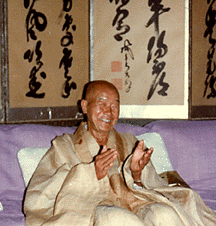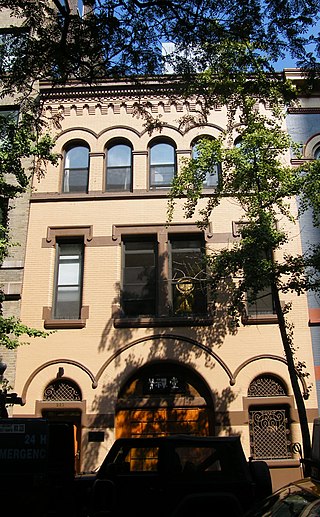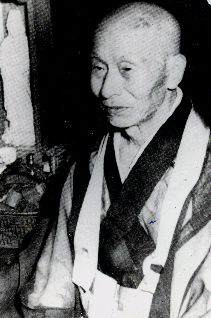
Sōtō Zen or the Sōtō school is the largest of the three traditional sects of Zen in Japanese Buddhism. It is the Japanese line of the Chinese Cáodòng school, which was founded during the Tang dynasty by Dòngshān Liánjiè. It emphasizes Shikantaza, meditation with no objects, anchors, or content. The meditator strives to be aware of the stream of thoughts, allowing them to arise and pass away without interference.
Rōshi (老師) is a title in Zen Buddhism with different usages depending on sect and country. In Rinzai Zen, the term is reserved only for individuals who have received inka shōmei, meaning they have completed the entire kōan curriculum; this amounts to a total of fewer than 100 people at any given time. In Sōtō Zen and Sanbo Kyodan it is used more loosely. This is especially the case in the United States and Europe, where almost any teacher who has received dharma transmission might be called rōshi, or even use it to refer to themselves, a practice unheard of in Japan.

The Rinzai school is one of three sects of Zen in Japanese Buddhism. The Chinese Linji school of Chan was first transmitted to Japan by Myōan Eisai. Contemporary Japanese Rinzai is derived entirely from the Ōtōkan lineage transmitted through Hakuin Ekaku (1686–1769), who is a major figure in the revival of the Rinzai tradition.
In Chan and Zen Buddhism, dharma transmission is a custom in which a person is established as a "successor in an unbroken lineage of teachers and disciples, a spiritual 'bloodline' (kechimyaku) theoretically traced back to the Buddha himself." The dharma lineage reflects the importance of family-structures in ancient China, and forms a symbolic and ritual recreation of this system for the monastical "family".
Kyozan Joshu Sasaki, Roshi was a Japanese Rinzai Zen teacher who sought to tailor his teachings to westerners, he lived in Los Angeles, United States. Joshu Sasaki opened dozens of centres and was founder and head abbot of the Mount Baldy Zen Center, near Mount Baldy in California, and of the Rinzai-Ji order of affiliated Zen centers. He was one of the most influential Zen masters in America.

Sōen Nakagawa was a Taiwanese-born Japanese rōshi and Zen Buddhist master in the Rinzai tradition. An enigmatic figure, Nakagawa had a major impact on Zen as it was practiced in the 20th century, both in Japan and abroad.

Japanese Zen refers to the Japanese forms of Zen Buddhism, an originally Chinese Mahāyāna school of Buddhism that strongly emphasizes dhyāna, the meditative training of awareness and equanimity. This practice, according to Zen proponents, gives insight into one's true nature, or the emptiness of inherent existence, which opens the way to a liberated way of living.

Eido Tai Shimano was a Rinzai Zen Buddhist roshi. He was the founding abbot of the New York Zendo Shobo-Ji in Manhattan and Dai Bosatsu Zendo Kongo-Ji monastery in the Catskill mountains of New York; he was forced to resign from that position of 40 years after revelations of a series of sexual relationships with and alleged sexual harassment of female students. This case was never brought to court and Shimano never admitted any wrongdoing.

New York Zendo Shobo-Ji, or Temple of True Dharma, is a Rinzai zen practice facility located in the upper East Side of Manhattan, New York, in the United States. It is operated by the Zen Studies Society. Founded on September 15, 1968, by Zen master Soen Nakagawa Roshi and Eido Tai Shimano Roshi, the building was converted from a garage, formerly a carriage house. Eido Tai Shimano Roshi, now deceased, was the founding abbot. He was succeeded on January 1, 2011, by the current abbot Roko Sherry Chayat Roshi.

Dai Bosatsu Zendo Kongo-ji, or International Dai Bosatsu Zendo Kongo-ji, is a Rinzai monastery and retreat center located in the Catskill Mountains of upstate New York. Maintained by the Zen Studies Society, Dai Bosatsu Zendo Kongo-ji is led by Shinge-Shitsu Roko Sherry Chayat Roshi. It is part of the Zen Studies Society, founded in 1956 to support the work of D.T. Suzuki.

Daiun Sogaku Harada was a Sōtō Zen monk who trained under both Sōtō and Rinzai teachers and became known for his teaching combining methods from both schools.
Shinge-shitsu Roko Sherry Chayat is the current abbot of the Zen Studies Society, based at the International Dai Bosatsu Zendo Kongo-ji monastery, outside Livingston Manor, NY, and at the New York Zendo Shobo-Ji on the Upper east Side of Manhattan. She is also the abbot of the Zen Center of Syracuse Hoen-ji. Chayat is an advocate for the use of meditation in medical settings, with Hoen-ji running the program Well/Being Contemplative Practices for Healing for healthcare professionals.

Shodo Harada, or Harada Rōshi, is a Rinzai priest, author, calligrapher, and head abbot of Sōgen-ji — a three-hundred-year-old temple in Okayama, Japan. He has become known as a "teacher of teachers", with masters from various lineages coming to sit sesshin with him in Japan or during his trips to the United States and Europe.
Zen master is a somewhat vague English term that arose in the first half of the 20th century, sometimes used to refer to an individual who teaches Zen Buddhist meditation and practices, usually implying longtime study and subsequent authorization to teach and transmit the tradition themselves.

The Zen Studies Society was established in 1956 by Cornelius Crane to help assist the scholar Daisetz Teitaro Suzuki in his work and to help promulgate Zen Buddhism in Western countries. It operates both New York Zendo Shobo-Ji in New York City and Dai Bosatsu Zendo Kongo-Ji in the Catskills area of New York State. Influenced by the teachings of Soen Nakagawa Roshi and Nyogen Senzaki, ZSS is one of the oldest organizations dedicated to the practice of Rinzai Zen in the United States.
Below is a timeline of important events regarding Zen Buddhism in the United States. Dates with "?" are approximate.
Daiyuzenji is a Rinzai Zen Buddhist temple located on the north side of Chicago, Illinois, in the United States.

Havredal Zendo - Cho-An is a Buddhist temple, in the Rinzai Zen tradition, founded by Choan Denko Mokudo Bertelsen. Cho-An is the first Zen temple building to be established in Denmark.
Zen institutions have an elaborate system of ranks and hierarchy, which determine one's position in the institution. Within this system, novices train to become a Zen priest, or a trainer of new novices.
The Zen tradition is maintained and transferred by a high degree of institutionalisation, despite the emphasis on individual experience and the iconoclastic picture of Zen.








